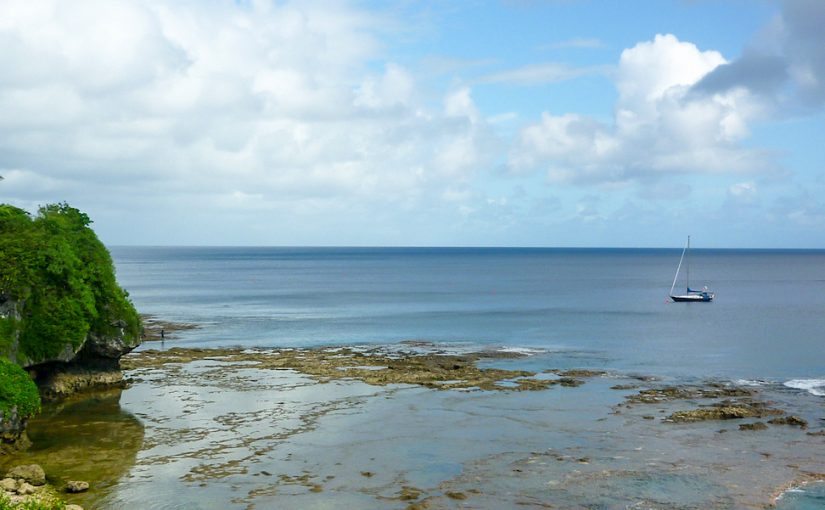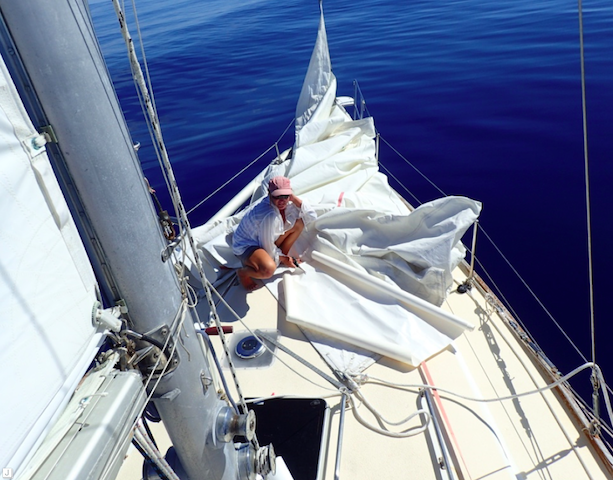By: Heather Francis
Our passage from French Polynesia to the small island nation of Niue was supposed to be just another downwind leg on the long voyage that was taking us slowly across the South Pacific. We were hoping the two dominant weather systems that often collide here like a meteorological roller derby would do as predicted and call a truce. But they didn’t play nice, and our mainsail got caught in the fray.
Most people have never even heard of Niue. On the charts it is just a speck in the vast Pacific Ocean somewhere between Bora Bora and the Kingdom of Tonga. It is nicknamed “The Rock of Polynesia” and lives up to its name, being little more than a tall, jagged protuberance some 20 miles long by 10 miles wide.
There are no coves or bays to shelter in. The only anchorage lies in the shadow of the small island itself and therefore is only protected when the wind blows from the right direction. When the wind shifts the Niue authorities order small craft to abandon their moorings. History has proven that boats are no match for a stiff westerly breeze and the vicious coral teeth of the island.
It was, of course, 0300 when the last knot in a string of mishaps occurred. Earlier in the day our GPS, chart plotter and depth-o-meter had stopped working, probably a wire connection that got water damaged when we shipped a wave and turned the cockpit into a swimming pool that leaked into the cabin. We managed to round the island before dark and found a little respite from the 30kt winds and the boisterous seas that had been chasing us for three days. However, without our instruments or working harbor lights, we were hesitant to approach the anchorage.

We decided to hove-to, reducing and then back the sails so that the boat would stay almost stationary. This maneuver would allow us to stay in the lee of the island, out of the wind and swell, but also stand a safe distance off the unknown shore until daylight. We set the sails and I went below for a rest while Steve sat watch. All was going well until late into the night when I was alone on deck.
As the boat came around in a slow and controlled gybe there was a soft ripping sound, like overused Velcro® being pulled apart. Then, there were light flapping noises above my head. Shining my flashlight upwards I saw a gash of black where white sailcloth should have been. The headboard and a scrap of sail hung limply from the halyard; the rest of the sail was a crumpled heap on the boom. The mainsail had ripped from leech to luff, intersecting the third reef points. Now the only thing connecting the two pieces of sail was the delicate leech line that danced freely in the breeze.
I lowered the sad bit of sail and tied the whole mess to the boom as the rain started, saturating my well-worn rain gear in a matter of minutes. Soaked and defeated, I bounced from foot to foot to keep warm, hoping that dawn would shed some positive light on our predicament.
In the morning, after fighting to sail directly upwind with only a headsail, we picked up a mooring, happy to be safe and calm after such a hard passage. Unfortunately, our rest would be brief as there were too many repairs to make to ensure we were shipshape and ready to put to sea if the weather changed. Steve tackled the electronic problems and I got to work on repairing the mainsail.
I dug out my Sailrite® sewing machine and a bag of leftover fabric scraps from previous projects. None of the pieces of Dacron® I had were big enough to cover the almost 6-foot tear, so I decided to use the next best thing I had: Sunbrella®. I knew Sunbrella was considerably heavier than sailcloth but it is UV stable and would give the sail the strength it needed to see us to the next island, over 500 nautical miles away, where I might find a sail loft that could make a proper repair.

I measured two long strips of fabric, six inches wide and a few inches longer than the rip. Using a hotknife I cut the Sunbrella, at the same time sealing the edges so that they wouldn’t fray in the wind. I made sure the sail was dry and free of as much salt as possible before using seamstick to adhere the patch across one side of the ripped sail. Then, carefully turning the sail over, I repeated the process on the opposite side, trying to match the edges of the Sunbrella through the layers of Dacron. With the patch temporarily in place, it was time to get to the business of sewing.
After changing to a size 22 needle and V-92 thread, I practiced on a multi-layer piece of fabric to get the tension correct. I wasn’t worried about whether my Sailrite machine could sew through so many layers of thick fabric, I had already put it to the test doing a few minor seam repairs on the heavy luff of the headsail. However, there was a lot of extra sail material that had to fit under the arm of the machine to sew totally across the patch. Not to mention the weight of the rest of the sail that now took up most of the cabin space. I employed Steve to help me wrestle the sail through the machine.

Using a wide zigzag stitch, I first outlined the top edge of the patch, checking to see that both front and back patches were being sewn at the same time. We got halfway across the repair, me pushing and Steve gently pulling on the sail, when we could no longer fit any more material under the needle and arm. Carefully, I reversed back along the same seam, Steve now feeding the sail back towards me. I did a similar seam on the bottom edge to anchor the patch to both pieces of sail.
The seamstick had done its job as a third set of hands and now the patch was secured to the sail. I sewed a zigzag seam along both edges of the rip at the center of the patch, reversing back over my work after reaching the same middle point on the repair. With one side of the repair complete, I turned the sail around and sewed in from the opposite edge, matching all the zigzag seams in the middle. Then I trimmed and secured the edges so there would be nothing to catch the breeze and open the wound.
We hoisted the repaired mainsail before lunch, not long after Steve had all our navigation equipment up and running again. Despite using grey Sunbrella, the scar of the repair was plainly visible, but only time would tell if it was as tough as it looked.

There was no sail loft in our next port of call, but it turns out we didn’t end up needing one. Thanks to my Sailrite sewing machine, our repaired mainsail carried us another 1500NM, and a few more windy nights at sea, without so much as a loose thread. A new mainsail was on our wish list but until then we wore our patch as a badge of honor, a testament to our ingenuity and self-reliance as sailors.
Heather Francis is originally from Nova Scotia, Canada. She and her Aussie partner, Steve, bought their Newport 41, Kate, and their Sailrite sewing machine in 2008 and have been sailing full time in the Pacific ever since. They are currently in the Philippines and you can follow their adventures at www.yachtkate.com
Who We Are
Sailrite is your one-stop DIY shop! We are a passionate crew of do-it-yourselfers who strive to equip you with the supplies and how-to knowledge you need to tackle your next project. Do you want to learn upholstery, leatherwork, canvaswork, hobby sewing, bag making or more? We have the fabric, tools, hardware, sewing machines and notions you need to master any DIY. And even if you’ve never sewn before, our tutorials and how-to videos are designed for beginners and experienced crafters alike.
Start your DIY journey today: www.sailrite.com






